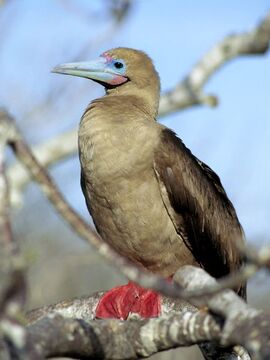
Smallest of the boobies, the red-foot feeds at sea, nests on the ground, and perches in coastal trees.
Fast Facts
- Type: Bird
- Diet: Carnivore
- Average life span in the wild: Over 20 years
- Size: 25 to 30 in (64 to 76 cm)
- Weight: 30 to 39 oz (850 to 1,100 g)
- Group name: Colony
- Did you know?
- Red-footed boobies may dive some 98 ft (30 m) to pursue prey.
These well known seabirds do not migrate, but live year-round in tropical and subtropical regions of the Atlantic, Pacific, and Indian Oceans. Familiar to boaters, they often follow (and sometimes land on) marine craft. Red-footed boobies feed at sea, but nest on land, perching in coastal trees and shrubs.
These are the smallest of more than half a dozen booby species. Red-footed boobies are strong flyers and can travel up to 93 miles (150 kilometres) in search of food. They often hunt in large groups, and are nimble enough to snare flying fish from the air. Boobies are well adapted for diving and feature long bills, lean and aerodynamic bodies, closeable nostrils, and long wings which they wrap around their bodies before entering the water. Red-footed boobies use these attributes to plunge-dive and capture fish that they spot from above with their sharp eyes. At night, they may dive for schooling squid that are visible because of their phosphorescence. Once in the water, the birds use their webbed feet to aid swimming.
Red-footed boobies appear in a variety of colour morphs but, of course, all have feet of the distinctive red colour which gives them their name.
These gregarious birds live in colonies and, during mating season, hundreds of animals may gather to pair up and mate. Females lay only one egg every 15 months, and both parents care for chicks. Young mature slowly, but the low reproduction rate is balanced by these birds' long lifespan—over 20 years.
The biggest threats to red-footed boobies are a fishing industry that thins their food source, and coastal development. The shoreline trees and shrubs these birds frequent are disappearing as human habitat consumes more of the world's coastlines.